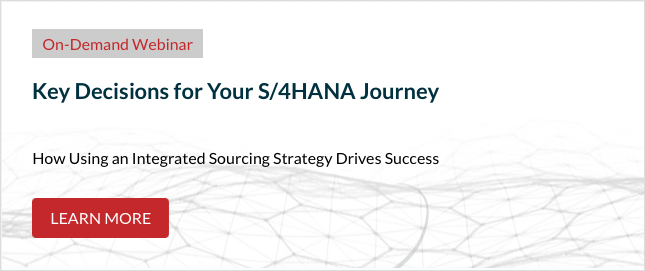- Devin Djerf
- Reading Time: 3 minutes

SAP recently announced its 2Q and half-year 2019 results on July 18th. Included in these earnings are the SAP support figures, which say a lot about how SAP positions its maintenance fees and how much they affect the bottom line of SAP’s revenue.
In a recent podcast published by our SAP Practice Leader, Len Riley dives deeper into SAP’s motivations and implications behind ECC to S/4HANA migrations and how maintenance fees affect a migration. The main question to be asked here is whether you are overpaying for maintenance. The reason SAP customers need to be asking this question is to avoid exposing themselves to the “sins of the past” and to make the necessary corrections in a renewal or new deal with SAP.
A significant portion of support revenue comes from clients renewing SAP deals, and there are two fundamental metrics that SAP considers when migrating a customer to S/4HANA:
- Percentage of renewal revenue, which SAP is constantly attempting to increase. This renewable revenue includes maintenance revenue, subscription revenue, and professional services revenue.
- Percentage of contract maintenance renewal.
It is worth noting from SAP’s 2Q and half-year 2019 results that software support totaled €5,692M out of €12,722M of total revenue, while new software licenses only accounted for about €1,600M. Maintenance fees accounted for 45% of total revenue.
Support revenue is up 6% YoY, a moderate increase from the first half of 2018. These numbers are very interesting, especially since support has become largely self-service and many customers are constantly seeking faster response times.
A customer’s maintenance cost, which is typically 22% of net license fees for annual support (plus annual adjustments for inflation), may be costing you more than you think. There are two metrics to be considered when doing a software migration or even a new deal with SAP:
- What is my product roadmap? What products do I currently have and what do I need in the future?
- What is the monetary value of this utilization? How much do I have or need and what does it cost?
Customers who are making the transition from ECC to S/4HANA also need to ask themselves which products are being used and which products are not. Additionally, customers need to know what their maintenance base will be after the migration occurs. What we have seen in the past is that customers are utilizing 70-75% of their purchased products, which may sound like a decent utilization percentage, but monetizing the other 25-30% can turn out to be a very hefty number, especially for large enterprises on an annual basis.
This underutilization, although somewhat minimal, can impact a customer’s business processes significantly and if reactionary measures are not taken, the customer can end up with a heavy cost. When it comes to maintenance and support fees, why should you be paying maintenance on a product you are not using?
In terms of customers paying support fees, SAP is less concerned about underutilization and more concerned about overutilization. In other words, SAP wants its customer to be in compliance and will position an increase to the maintenance base if it means more revenue. SAP often pushes its customers to get on the latest version of its enhancement packs, which does not always lead to increased functionality, especially if you are underutilized and not getting the most out of the support update.
In addition, as vendors push customers to transition to cloud solutions, SAP has a strategy of incentivizing customers to migrate to new SaaS products and platforms. This will result in customers purchasing additional products that they may not use and will then result in further increases in support revenue for SAP.
Many companies are unaware of their asset base and what their utilization is, so it is important to know your product usage and to continue to do your due diligence. Customers are often entitled to a wide array of products that are being underutilized. Avoid the mistake of taking unused or underutilized products and implementing them into the newly migrated SAP system.
Be aware of your maintenance base and take appropriate action when assessing utilization. Being proactive and taking the necessary steps to avoid paying support for products underutilized is essential in maintaining a proper product roadmap.
Comment below, follow me on Twitter @dcdjerf and follow UpperEdge on Twitter and LinkedIn.

